Wastewater To Biogas: From Trash To Treasure
By Jesper Køks Andersen and Zahra Khadir
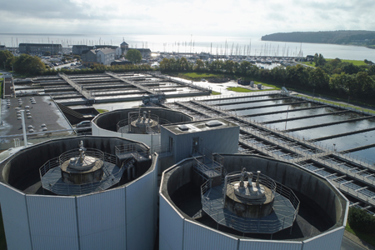
How U.S. wastewater treatment plants can learn from the example of others to transition into wastewater resource recovery facilities and create more sustainable, livable communities.
In Denmark, a country so small it could seemingly be tucked away into one of the Great Lakes, our approach to transforming wastewater into biogas extends far beyond processing. It gives Danish utilities economic advantages, energy security, and environmental benefits, and is part of our national strategy to reach climate neutrality. Embarking on a journey toward efficient wastewater treatment over 40 years ago, Denmark has dedicated itself to unlocking wastewater’s full potential as a resource. This journey has placed our small nation at the forefront of developing solutions and practices to responsibly and innovatively recover the resources from our waste. In this process, Danish utilities have transformed how we view and utilize wastewater, from trash to treasure.
The Benefits Of Biogas Production From Wastewater
Now, let’s explore why transitioning to biogas production from wastewater is a choice worth considering:
A source of renewable energy: Utilizing biogas means tapping into a significant renewable energy source. For wastewater utilities, this shift is a step toward greener operations, aligning with global environmental goals while minimizing their carbon footprint. This approach plays a crucial role in reducing greenhouse gas emissions, minimizing the ecological impact of waste management. Furthermore, utilizing digestate as a biofertilizer effectively closes the nutrient cycle, promoting sustainable agricultural practices.
Economic advantages: Generating energy in-house can substantially cut operational costs for wastewater utilities. Moreover, the ability to sell excess energy offers a significant financial incentive, enhancing the economic feasibility of investing in biogas technology.
Energy security: Producing energy onsite means utilities are less affected by fluctuations in the energy market. This level of self-sufficiency is especially valuable, as it ensures a more stable and secure energy supply.
Opting for biogas production from wastewater offers a spectrum of benefits, from environmental and economic gains to promoting technological innovation. It’s a holistic approach that positions wastewater utilities as leaders in sustainable practices and resource management.
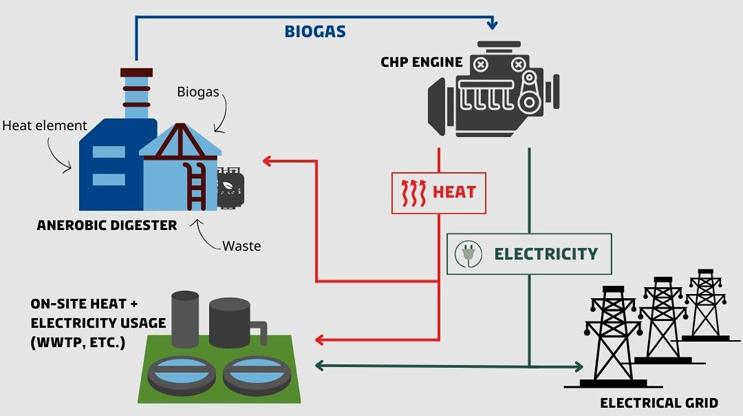
Denmark’s Historic Journey In Biogas Development
Denmark’s journey toward harnessing biogas from wastewater treatment began in the early 20th century, with the first digesters being installed at Danish wastewater treatment plants in the 1920s. These early initiatives marked the start of what later became a resource-recovery evolution. The first digesters were installed to stabilize sludge, and the gas was merely used to warm up digesters. Now, we produce biogas, electricity, and heat from sludge and recover nutrients and sand.
The 1987 Danish Aquatic Environment Action Plan was another important moment, addressing challenges like oxygen depletion in aquatic environments. This plan demanded a significant reduction in nutrient discharge from wastewater, which led to nationwide upgrades of treatment facilities. These modernizations not only met environmental standards but also accelerated the development of biogas infrastructure.
In recent years, the production of renewable biogas has become central to Denmark’s strategy to reach climate neutrality by 2050, and to specifically reach climate neutrality for the water sector by 2030. The water sector’s emissions are often overlooked. Yet water use, storage and distribution, and lack of wastewater treatment are responsible for approximately 10% of greenhouse gas emissions globally. The Danish government has backed up the ambitious targets with a range of incentives, including water sector emission reporting and subsidies for biogas technology development. The government’s initiatives have contributed to making Denmark a global leader in this field.
From Wastewater To Clean Energy
In Denmark’s advanced wastewater treatment processes, the utilization of sludge is strategic. By accumulating larger quantities in digestion tanks, we significantly enhance energy production through biogas. This method is not only about efficient waste management but also about maximizing energy recovery.
Our process carefully manages the aeration of wastewater. By employing precise control mechanisms and real-time online water quality measurements, we effectively reduce the nitrogen content in the water. Such attention to detail ensures that every step of the treatment contributes to a cleaner, more sustainable output.
Energy efficiency is a key focus, with the introduction of energy-efficient pumps improving the transportation of wastewater. We prioritize the strategic use of existing equipment, opting for upgrades over immediate replacements when feasible. This approach extends the life of our infrastructure while enhancing its efficiency.
Energy conservation is further maintained by improved insulation, reduced heating requirements, and the innovative use of heat pumps. We also recover heat from equipment like transformers, ensuring that no energy goes to waste.
The Danish Method Of Biogas Production
Collection and pretreatment: Our journey begins with the collection of wastewater from various sources. The pretreatment stage is critical, involving processes like screening and sedimentation, and sometimes advanced techniques like thermal hydrolysis. These steps break down complex molecules, preparing the organic material for digestion.
Anaerobic digestion: At the heart of our process is anaerobic digestion. In an oxygen-free environment, specific microorganisms metabolize the organic matter, producing biogas rich in methane. We carefully maintain optimal conditions for microbial activity to ensure the efficiency of this stage.
Biogas upgrading and cleaning: Once we have the biogas, it’s not ready for immediate use. It undergoes a cleaning or upgrading process, removing contaminants like hydrogen sulfide and moisture, and sometimes separating carbon dioxide to increase methane concentration.
Energy generation through CHP: Our use of combined heat and power (CHP) technology is a key highlight. These units efficiently convert biogas into electricity and heat, maximizing the energy content of the biogas and providing sustainable solutions for both power and heating needs.
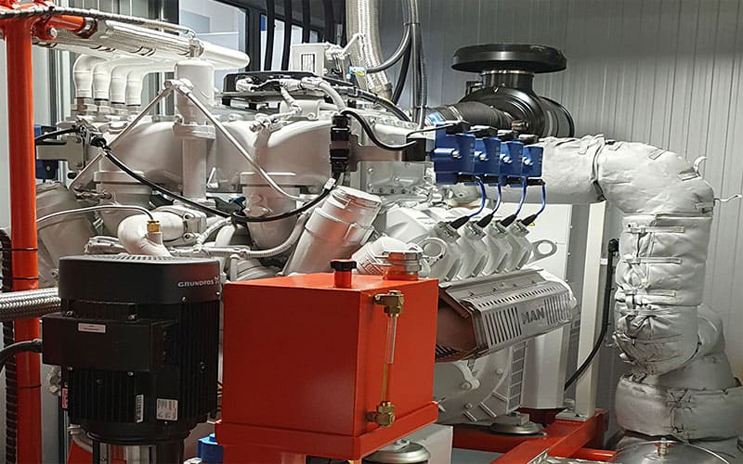
Digestate management: Finally, the process generates digestate, a nutrient-rich byproduct. This material is then used as biofertilizer, contributing to sustainable agricultural practices.
In summary, Denmark’s approach to transforming wastewater into biogas is a combination of innovation, efficiency, and sustainability. Each step of our process reflects our commitment to environmental practices and sustainable solutions.
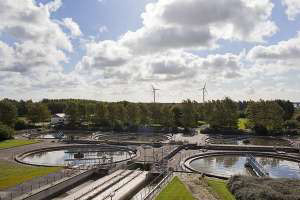 |
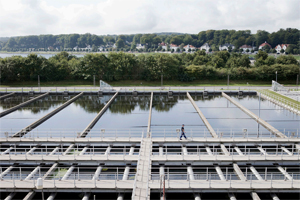 |
Danish Technology In Action In The U.S.
Transitioning from the benefits of biogas production, let’s look at a practical implementation of Danish technology in the U.S. The Kishwaukee Water Reclamation District in the U.S. has taken significant steps toward sustainable energy. The Illinois facility has adopted a Danish-built CHP generator, using it to convert sewage into electrical power. This innovative application of CHP technology allows for efficient conversion of biogas, obtained from wastewater, into a source of electricity. The implementation of technology has gone beyond supplementing the facility’s power needs. Kishwaukee has achieved a level of efficiency where it is capable of selling surplus energy to Meta’s DeKalb Data Center, showcasing a successful and economically viable model of wastewater-to-energy conversion. The achievement not only highlights the effectiveness of Danish wastewater technologies but also sets an example for international collaboration in renewable energy and sustainable waste management.
Exploring The Untapped Biogas Potential In U.S. WWTPs
Following the example set by the Kishwaukee Water Reclamation District, it’s clear that the potential for biogas production in U.S. wastewater treatment plants (WWTPs) is significant yet largely underused. The U.S. EPA estimates that an impressive amount of digester gas — about 1 cubic foot from every 100 gallons of wastewater — can be produced, emphasizing the vast amount of untapped potential in this sector.
The energy generated from these WWTPs could potentially meet up to 12% of the national electricity demand, according to the EPA. This underexplored area in biogas production is more than just a solution for electricity generation; it offers a versatile energy source for heating and transportation fuel. Implementing innovative treatment methods could increase this efficiency, transforming waste management into a significant source of renewable energy.
In U.S. WWTPs, the opportunity for biogas production offers not just environmental benefits but also economic ones. By utilizing this technology, already effective in U.S. sectors like food processing and farming, these facilities could significantly reduce greenhouse gas emissions while generating a cost-effective source of renewable energy.
Investing in biogas technology isn’t just about the present; it’s about paving the way for the future. It promotes innovation and technological development, encouraging more efficient and ecofriendly energy production methods, and it sets a great example for other sectors to follow.
Bringing Danish Innovations To The U.S.
As we explore the potential for biogas production in U.S. WWTPs, the Water Technology Alliance (WTA) at the Danish Diplomatic Representations is willing to promote knowledge-sharing, partnerships, and exchange of best practices across the Danish and North American water sectors. If you’re considering how Danish expertise could benefit your WWTPs, the WTA team in Chicago, Palo Alto, Houston, and Washington, D.C., is ready to assist. Feel free to reach out to our team for further information.
 About The Authors
About The Authors
Jesper Køks Andersen is the consul general of Denmark in Chicago and head of water, where he leads the Danish Water Technology Alliance. With a strong background in the Danish Ministry of Foreign Affairs, Jesper specializes in export counselling for Danish businesses in the U.S. and has extensive experience in strengthening DenmarkU.S. relations, particularly in sustainable water management.
 Zahra Khadir is a marketing and communication advisor based in Chicago, primarily working with the Water Technology Alliance. Her role involves leading marketing and communication strategies to promote and support the WTA’s initiatives in water technology and management.
Zahra Khadir is a marketing and communication advisor based in Chicago, primarily working with the Water Technology Alliance. Her role involves leading marketing and communication strategies to promote and support the WTA’s initiatives in water technology and management.
